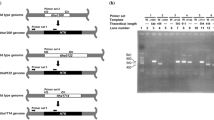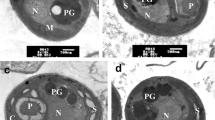Abstract
Catalases are key antioxidant enzymes in aerobic organisms. Myxococcus xanthus expresses two monofunctional catalases, small-subunit Cat1 and large-subunit Cat2. The Km of H2O2 for recombinant Cat1 and Cat2 were 14.0 and 9.0 mM, respectively, and the catalytic efficiency of Cat2 (kcat/Km = 500 sec−1 mM−1) was 4-fold higher than that of Cat1. The activity ratio of Cat1 to Cat2 in the exponential growth phase of M. xanthus was 1 to 3–4. A Cat1-deficient strain was constructed, whereas a Cat2-deficient strain could not be produced In H2O2-supplemented medium, the cat1 mutant exhibited marked growth retardation and a longer generation time than the wild-type (wt) strain. After 2 h of incubation in 0.5 mM H2O2-supplemented medium, the catalase activity of the wt strain significantly increased (by 64-fold), but that of the cat1 mutant strain did not. Under starvation-induced developmental conditions, catalase activity was induced by approximately 200-fold in both wt and cat1 strains, although in the mutant the activity increase as well as spore formation occurred one day later, indicating that the induction of catalase activity during starvation was due to Cat2. In wt starved cells, catalase activity was not induced by H2O2. These results suggest that Cat2 is the primary housekeeping catalase during M. xanthus growth and starvation-induced development, whereas Cat1 may have a complementary role, being responsible for the rapid degradation of H2O2 in proliferating vegetative cells subjected to oxidative stress.
Similar content being viewed by others
References
Bagyan, I., Casillas-martinez, L., and Setlow, P. 1998. The katX gene, which codes for the catalase in spores of Bacillus subtilis, is a forespore-specific gene controlled by σF, and KatX is essential for hydrogen peroxide resistance of the germinating spore. J. Bacteriol. 180, 2057–2062.
Brown, S.M., Howell, M.L., Vasil, M.L., Anderson, A.J., and Hassett, D.J. 1995. Cloning and characterization of the katB gene of Pseudomonas aeruginosa encoding a hydrogen peroxide-inducible catalase: purification of KatB, cellular localization, and demonstration that it is essential for optimal resistance to hydrogen peroxide. J. Bacteriol. 177, 6536–6544.
Brunori, M. and Rotilio, G. 1984. Biochemistry of oxygen radical species. Methods Enzymol. 105, 22–35.
Buchmeier, N.A., Libby, S.J., Xu, Y., Loewen, P.C., Switala, J., and Guiney, D.G. 1995. DNA repair is more important than catalase for Salmonella virulence in mice. J. Clin. Invest. 95, 1047–1053.
Chelikani, P., Donald, L.J., Duckworth, H.W., and Loewen, P.C. 2003. Hydroperoxidase II of Escherichia coli exhibits enhanced resistance to proteolytic cleavage compared to other catalases. Biochemistry 42, 5729–5735.
Cho, Y.H. and Roe, J.H. 1997. Isolation and expression of the catA gene encoding the major vegetative catalase in Streptomyces coelicolor Müller. J. Bacteriol. 179, 4049–4052.
Claiborne, A. and Fridovich, I. 1979. Purification of the o-dianisidine peroxidase from Escherichia coli B. J. Biol. Chem. 254, 4245–4252.
Elkins, J.G., Hassett, D.J., Stewart, P.S., Schweizer, H.P., and McDermott, T.R. 1999. Protective role of catalase in Pseudomonas aeruginosa biofilm resistance to hydrogen peroxide. Appl. Environ. Microbiol. 65, 4594–4600.
Goulart, C.L., Barbosa, L.C., Bisch, P.M., and von Krüger, W.M.A. 2016. Catalases and PhoB/PhoR system independently contribute to oxidative stress resistance in Vibrio cholerae O1. Microbiology 162, 1955–1962.
Harita, D., Kanie, K., and Kimura, Y. 2021. Enzymatic properties of Myxococcus xanthus exopolyphosphatases mxPpx1 and mxPpx2. Biochim. Biophys. Acta Proteins Proteom. 1869, 140660.
Hochman, A. and Shemesh, A. 1987. Purification and characterization of a catalase-peroxidase from the photosynthetic bacterium Rhodopseudomonas capsulata. J. Biol. Chem. 262, 6871–6976.
Ibrahim, M.A., Ghazy, A.M., and Masoud, H.M.M. 2015. Catalase from larvae of the camel tick Hyalomma dromedarii. Biochem. Biophys. Rep. 4, 411–416.
Kandukuri, S.S., Noor, A., Ranjini, S.S., and Vijayalakshmi, M.A. 2012. Purification and characterization of catalase from sprouted black gram (Vigna mungo) seeds. J. Chromatogr. B Analyt. Technol. Biomed. Life Sci. 889–890, 50–54.
Kimura, Y., Tanaka, C., Sasaki, K., and Sasaki, M. 2017. High concentrations of intracellular Ap4A and/or Ap5A in developing Myxococcus xanthus cells inhibit sporulation. Microbiology 163, 86–93.
Klotz, M.G., Klassen, G.R., and Loewen P.C. 1997. Phylogenetic relationships among prokaryotic and eukaryotic catalases. Mol. Biol. Evol. 14, 951–958.
Loewen, P.C. and Switala, J. 1987a. Purification and characterization of catalase-1 from Bacillus subtilis. Biochem. Cell Biol. 65, 939–947.
Loewen, P.C. and Switala, J. 1987b. Multiple catalases in Bacillus subtilis. J. Bacteriol. 169, 3601–3607.
Loewen, P.C. and Switala, J. 1988. Purification and characterization of catalase-2 from Bacillus subtilis. Biochem. Cell Biol. 66, 707–714.
Loewen, P.C., Switala, J., and Triggs-Raine, B.L. 1985. Catalases HPI and HPII in Escherichia coli are induced independently. Arch. Biochem. Biophys. 243, 144–149.
Loprasert, S., Vattanaviboon, P., Praituan, W., Chamnongpol, S., and Mongkolsuk, S. 1996. Regulation of the oxidative stress protective enzymes, catalase and superoxide dismutase in Xanthomonas—a review. Gene 179, 33–37.
Ma, M. and Eaton, J.W. 1992. Multicellular oxidant defense in unicellular organisms. Proc. Nat. Acad. Sci. USA 89, 7924–7928.
Meir, E. and Yagil, E. 1984. Catalase-negative mutants of Escherichia coli. Curr. Microbiol. 11, 13–18.
Mizuno, K., Fukuda, D., Kakihara, M., Kohno, M., Ha, T.L., Sonomura, K., and Ishizaki, A. 2000. Purification and gene cloning of catalase from Staphylococcus warneri ISK-1. Food. Sci. Technol. Res. 6, 324–329.
Nadler, V., Goldberg, I., and Hochman, A. 1986. Comparative study of bacterial catalases. Biochem. Biophys. Acta 882, 234–241.
Nariya, H. and Inouye, M. 2008. MazF, an mRNA interferase, mediates programmed cell death during multicellular Myxococcus development. Cell 132, 55–66.
Okada, M. and Kimura, Y. 2022. Characterization of glutamate-cysteine ligase and glutathione synthetase from the δ-proteobacterium Myxococcus xanthus. Proteins 90, 1547–1560.
Okai, Y., Sato, E., Higashi-Okai, K., and Inoue, M. 2004. Effect of endocrine disruptor para-nonylphenol on the cell growth and oxygen radical generation in Escherichia coli mutant cells deficient in catalase and superoxide dismutase. Free Radic. Biol. Med. 37, 1412–1418.
Sevinc, M.S., Ens, W., and Loewen, P.C. 1995. The cysteines of catalase of Escherichia coli, including Cys438 which is blocked, do not have a catalytic role. Eur. J. Biochem. 230, 127–132.
Shi, X., Feng, M., Zhao, Y., Guo, X., and Zhou, P. 2008. Overexpression, purification and characterization of a recombinant secretary catalase from Bacillus subtilis. Biotchnol. Lett. 30, 181–186.
Siegele, D.A. and Kolter, R. 1992. Life after log. J. Bacteriol. 174, 345–348.
Storz, G., Tartaglia, L.A., Farr, S.B., and Ames, B.N. 1990. Bacterial defenses against oxidase stress. Trends Genet. 6, 363–368.
Switala, J. and Loewen, P.C. 2002. Diversity of properties among catalases. Arch. Biochem. Biophys. 401, 145–154.
Yumoto, I., Fukumori Y., and Yamanaka, T. 1990. Purification and characterization of catalase from a facultative alkalophilic Bacillus. J. Biochem. 108, 583–587.
Watson, B. and Dworkin, M. 1968. Comparative intermediary metabolism of vegetative cells and microcysts of Myxococcus xanthus. J. Bacteriol. 96, 1456–1473.
Wenk, M., Ba, Q., Erichsen, V., MacInnes, K., Wiese, H., Warscheid, B., and Koch, H.G. 2012. A universally conserved ATPase regulates the oxidative stress response in Escherichia coli. J. Biol. Chem. 287, 43585–43598.
Whitworth, D.E. 2008. Myxobacteria: Multicellularity and Differentiation. ASM Press, Washington D.C., USA.
Wireman, J.W. and Dworkin, M. 1977. Developmentally induced autolysis during fruiting body formation by Myxococcus xanthus. J. Bacteriol. 129, 798–802.
Zámocký, M., Gasselhuber, B., Furtmüller, P.G., and Obinger, C. 2012. Molecular evolution of hydrogen peroxide degrading enzymes. Arch. Biochem. Biophys. 525, 131–144.
Acknowledgements
None.
Author information
Authors and Affiliations
Corresponding author
Additional information
Conflict of Interest
The authors have no conflict of interest to report.
Supporting information
Rights and permissions
About this article
Cite this article
Yoshio, K., Yoshioka, Y. & Toshikuni, K. Physiological roles of catalases Cat1 and Cat2 in Myxococcus xanthus. J Microbiol. 60, 1168–1177 (2022). https://doi.org/10.1007/s12275-022-2277-7
Received:
Revised:
Accepted:
Published:
Issue Date:
DOI: https://doi.org/10.1007/s12275-022-2277-7




